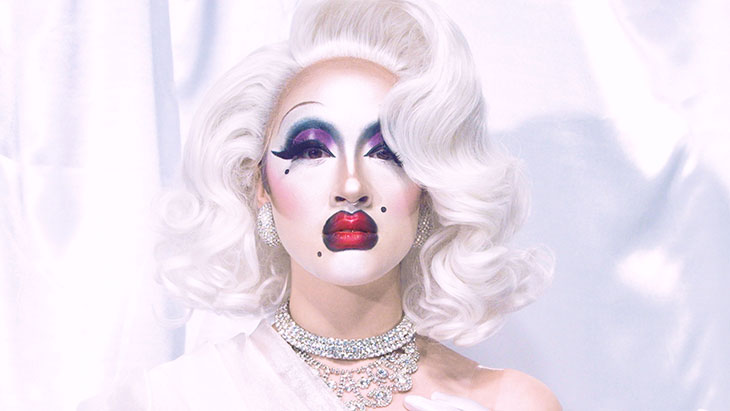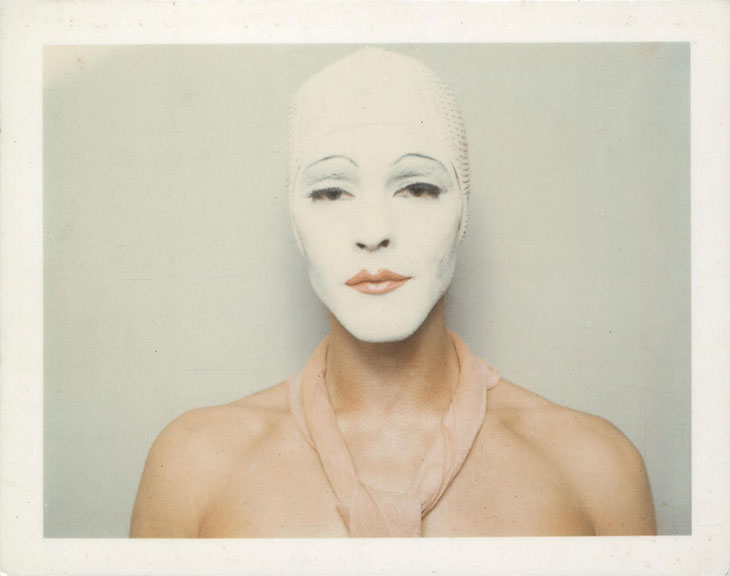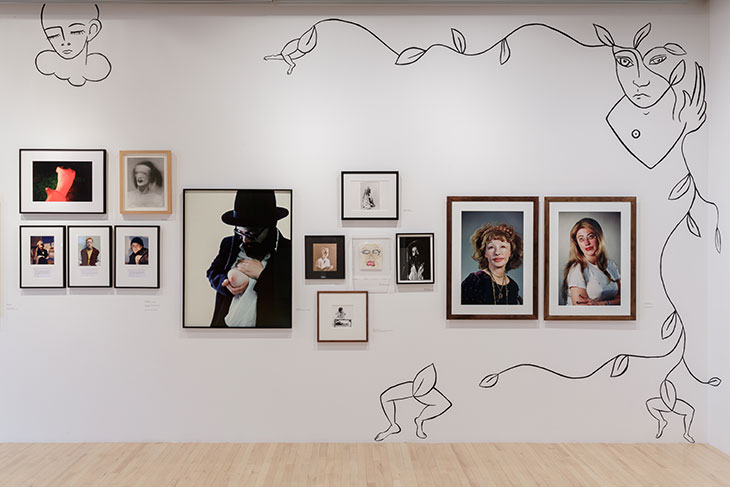‘Carry your gaze up and down there for you to see, she’s there, she’s here. She postures in context. So go on – look at her.’ With a laconic yet defiant tone, these words are spoken in the video work by Victoria Sin – Tell me everything you saw and what you think it means (2018) – who is one of the drag artists featured in the Hayward Gallery’s exhibition ‘DRAG: Self-Portraits and Body Politics’.
This timely exhibition examines how the way we look, at ourselves and at others, has been conditioned by a series of gendered, racial, class and colonial structures. Curator Vincent Honoré brings together a diverse collection from more than 30 artists who use drag. Comprising mostly photographs and videos, the show includes work from the 1960s to the present day, but is decidedly non-chronological, fostering a space where the works are displayed without hierarchy, but in constant conversation with each other.
Cthulhu Through the Looking Glass (still; 2017), Victoria Sin. Courtesy the artist

As Victoria Sin’s video articulates, drag can powerfully interrogate the structures of the gaze. Sin is a female-bodied non-binary drag queen, examining how Western ideals of femininity are produced and consumed. As Sin sits confrontationally, their costume exaggerates and deconstructs gendered tropes – they flaunt sheeny plastic boobs, and wear a shapely white wig that takes Marilyn Monroe’s blonde coiffure to its logical conclusion. But rather than sit as a passive object of the viewer’s desire or interest, Sin commands that we look at them – and they are totally in charge of this exchange. For Sin has entirely constructed this artifice of femininity: it is unrefutably their own design. And in a further assertion of their status, Sin instructs us to keep looking even as their image fades away, their voice detailing with relish movements that the viewer can no longer see. Here, drag is a tool for queer bodies to reclaim the act of looking – no longer as subjects that can be visually policed or violated, but as the ones in charge, setting their own parameters.
Throughout the exhibition, we see the ways queer artists through the decades have used drag to exercise agency. Queer bodies are often erased from cultural narratives; as a strategy, many artists use drag as a way to take up space, forcing us to acknowledge the presence of their frequently outcast bodies. A mesmerising instance of this is Cerith Wyn Evans and Leigh Bowery’s video, Leigh Bowery at the Anthony d’Offay Gallery 1988 (1988). This video captures Bowery, a New York artist and club kid famed for gender-defying costumes and conceptual make-up, sitting behind a two-way mirror in a gallery in London for the course of a week. With looks ranging from painted blue skin with orange polka dots to Cher-length black hair, huge nose rings and an all-consuming fur coat, Bowery dominates a chaise longue, forcing viewers, as well as himself, to face him and his reflection – refusing to be ignored.
Renais sense (White Mask) (1974/2014), Ulay.

But as much as drag is a way to attract attention, it is also a tool with which to divert it, and the exhibition relays this tension skilfully. In her video On Stage (1972/1996), Suzy Lake questions whether drag is ‘an act of concealment’ or a revelation of ‘our true self’. We see this negotiation play out in an image from Ulay’s series of photographs, Renais sense. Ulay used polaroid film to create his ‘auto-portraits’, documenting the construction of different – and differently gendered – identities. In Renais sense (White Mask) (1974/2014) he plasters his face with white paint, effectively becoming a ghost melding with the white background, only to again become visible with the application of red lips and new eyebrows. For while drag might be a proclamation of the self, it is also a way to recreate it – the body becomes a blank canvas, from which an entirely new person can be born.
A similar act seems to occur in Tony Morgan’s Herman Waves (1974), a series of nine photographs in which Morgan attempts to document his self-portrait in drag. The subject feels constantly just out of reach – it is concealed in shadow, often blurry, white paint covering the face. But rather than an act of self-negation, perhaps this is one of self-reflection: less a disappearing act, and more an artist tussling through their identity.
Installation view of ‘DRAG’ at the Hayward Gallery’s HENI Project Space, London. Photo: Tim Bowditch

There are many wonderfully defiant images of drag presented in the exhibition, but we’re also exposed to its processes – for the construction of drag is a critical part of its artistic potency. I was particularly moved by Ana Mendieta’s Untitled (Facial Hair Transplants) (1972), in which Mendieta constructs a masculine alter-ego by attaching facial hair donated by a white male friend standing beside her. We witness how the labour of drag can be shared – how drag can redistribute codes of masculinity and femininity across intersecting social groups.
Indeed, the infinite intersections of drag, the myriad of states that it can exist in, are what the exhibition relays so successfully. From erasing the self to reformulating it, from making oneself known to becoming invisible, from drag as a façade to drag as a process, the enduring, everchanging and uproarious politics of the art form are celebrated. I only wish that the exhibition, which occupies a single room in the Hayward Gallery’s free HENI Project Space, had the luxury of being more expansive, for my overarching feeling was that I was desperate for more.
‘DRAG: Self-portraits and Body Politics’ is at the Hayward Gallery, London, until 14 October.



